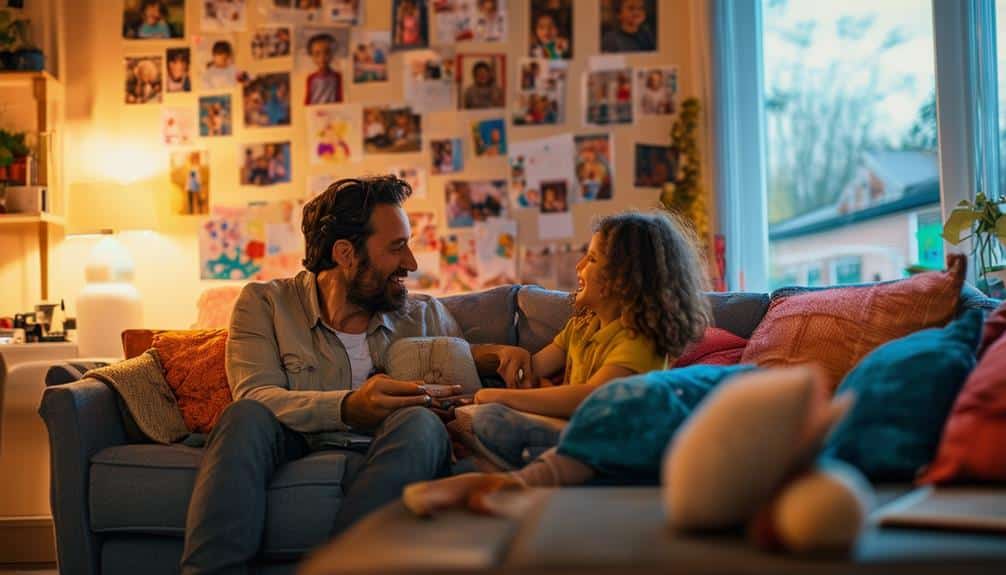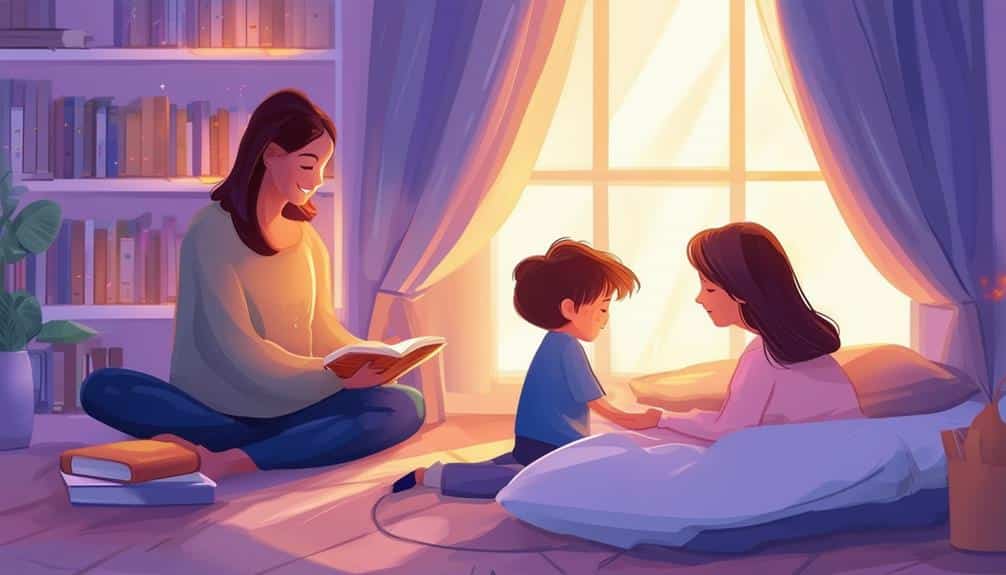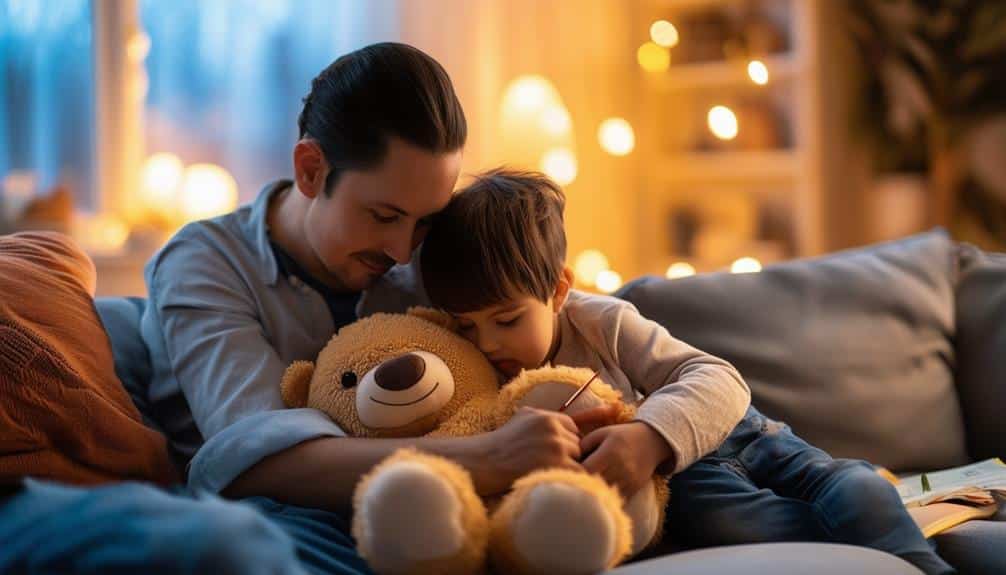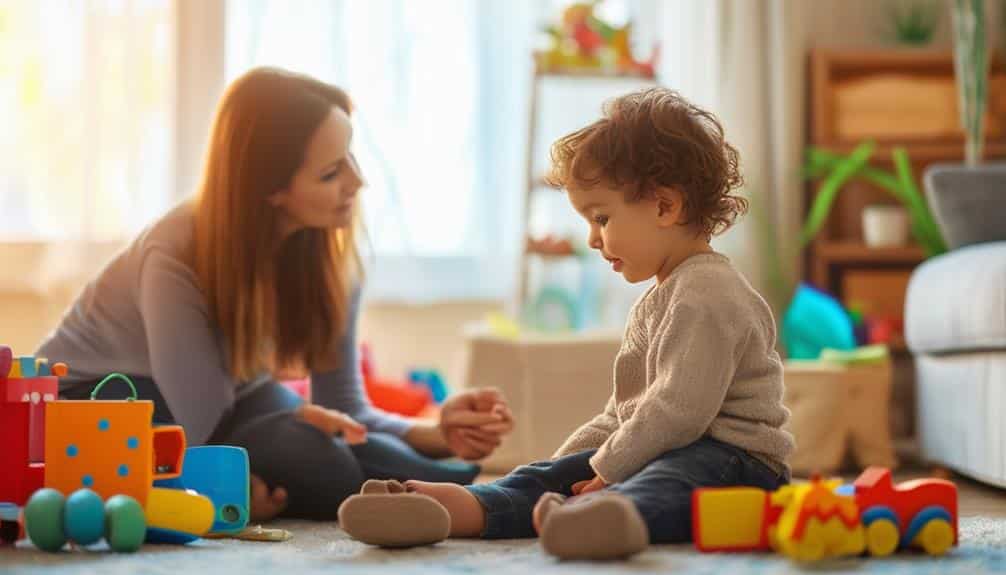Helping children reduce anxiety requires a multifaceted approach that starts with understanding their worries. Recognize signs like stomachaches or panic attacks, and create a safe space for open communication. Use age-appropriate language and validate their feelings to help reduce anxiety and make them feel heard.
Incorporate practical strategies, such as gradually exposing yourself to anxiety triggers and teaching deep breathing techniques. At home, dedicate focused one-on-one time, use positive reinforcement, and teach relaxation methods. If anxiety persists, seek guidance from primary care providers, pediatric occupational therapists, and other mental health professionals for a more thorough exploration of practical techniques and strategies.
Key Takeaways
- Encourage open communication, creating a safe space for children to express their feelings without judgment.
- Teach and practice relaxation techniques, such as deep breathing, to help children manage anxiety.
- Identify and gradually expose children to anxiety triggers, supporting them with coping strategies.
- Validate children’s feelings and use positive reinforcement to reward brave behavior and efforts.
- Seek professional help from mental health specialists if anxiety significantly impacts the child’s daily life.
Understanding Childhood Anxiety
Understanding childhood anxiety requires recognizing its diverse manifestations, including excessive worries and physical symptoms like stomachaches and panic attacks. Children experiencing anxiety may show signs such as academic decline, social withdrawal, and disrupted sleep patterns. These manifestations can often be subtle, making it essential for caregivers and educators to remain vigilant and empathetic.
Identifying triggers is vital in helping children manage their anxiety effectively. Triggers can vary widely, ranging from academic pressures to social interactions, and understanding these can pave the way for more targeted and supportive interventions. Recognizing these triggers early allows for timely and appropriate responses, reducing the negative impact on a child’s well-being.
Building resilience is another vital strategy in managing childhood anxiety. Encouraging problem-solving skills and fostering positive self-talk can empower children to approach challenges confidently. This resilience not only helps in mitigating anxious symptoms but also promotes overall mental health.
Encouraging Open Communication

Encouraging open communication is vital in helping children feel understood and supported in managing their anxiety. Children need to feel safe expressing their worries and fears without judgment. By actively listening to their concerns, you validate their feelings and build trust, essential for effective anxiety communication. Creating a safe environment where children feel comfortable discussing their anxiety can significantly reduce their stress levels.
Using age-appropriate language and concepts helps children articulate their emotions more effectively. Simplifying complex ideas into terms they understand allows them to express their worries better. Establishing regular check-ins can maintain ongoing communication about their anxiety, enabling you to monitor progress and adjust support strategies as needed.
Encouraging children to open up about their feelings fosters mutual understanding and respect. When they see that their concerns are taken seriously, it reinforces their sense of security and trust. This open dialogue equips them with the tools to manage their anxiety more effectively and promotes long-term well-being. Open communication is not just a one-time effort but a continuous process that nurtures resilience and growth in children.
Practical Solutions and Strategies

Building on the foundation of open communication and implementing practical solutions and strategies can empower children to manage their anxiety effectively. One essential approach is to help children face their fears gradually, which can build resilience and reduce anxiety levels over time. This process, known as exposure therapy, involves slowly and systematically exposing children to their fears in a controlled manner, allowing them to become less sensitive to anxiety-provoking stimuli.
Teaching deep breathing techniques is another essential strategy. Deep breathing can help children calm their nervous systems during moments of heightened anxiety. Encouraging children to take slow, deep breaths can provide immediate relief and is a practical tool they can use in various situations.
Supporting children in identifying and managing their anxiety triggers is also vital. Creating a plan to address specific triggers can help children feel more in control and less overwhelmed. It’s essential to validate their feelings and acknowledge their anxiety while promoting healthy coping mechanisms.
Furthermore, it helps children understand that anxiety is a normal emotion, but when excessive, it may require intervention and support. By combining these evidence-based strategies, caregivers can significantly reduce anxiety and foster a sense of security and well-being in children.
Managing Anxiety at Home

Establishing a nurturing home environment is essential for helping children manage anxiety effectively. Parents and caregivers are pivotal in creating a safe, supportive space where children can thrive emotionally. Here are actionable steps to guide you:
- Set aside one-on-one time: Dedicate daily moments without media distractions to engage with your child. This fosters open communication and strengthens emotional bonds, making identifying specific worries and anxieties easier.
- Teach relaxation techniques: Simple practices such as deep breathing and muscle relaxation can empower children with practical tools to manage anxiety. These techniques can be integrated into daily routines to promote a sense of calm.
- Use praise and positive reinforcement: Acknowledge and celebrate your child’s efforts and achievements. Positive reinforcement can significantly boost a child’s self-esteem and confidence, reducing anxiety.
- Reward brave behavior: Encourage your child to face their fears by rewarding brave behaviors. Offering praise and small incentives can motivate children to confront challenges, helping them navigate anxiety more effectively.
Providing a safe space for expression is crucial for children with anxiety. Please encourage them to share their feelings without judgment, fostering an environment where they feel heard and understood. This holistic approach can greatly help kids in reducing anxiety at home.
When to Seek Professional Help

If your child’s anxiety is severe and persistent, impacting their daily functioning and well-being, it may be time to seek professional help. It is essential to talk with your child’s primary care provider, such as a GP or pediatrician, who can offer guidance and support in managing your child’s anxiety. These professionals can assess the severity of the anxiety and find appropriate interventions.
Involving the school is also essential if anxiety is affecting your child’s academic performance or social interactions. Teachers, school counselors, and other trusted adults in the school environment can provide valuable support and help reduce the child’s anxiety by creating a supportive and understanding atmosphere.
Consider consulting with a Child and Adolescent mental health professional for more expert care. These experts can help make a plan tailored to your child’s needs, including therapy or other interventions. It’s essential to avoid things that exacerbate the anxiety and focus on helping your child develop coping strategies.
Additionally, reaching out to mental health helplines can provide immediate assistance and resources for getting support. Remember, seeking professional help is a proactive step in helping your child navigate and reduce their anxiety effectively.
Frequently Asked Questions
How to
How to Help Reduce Anxiety In a Child?
Treating an anxious child involves a multifaceted approach, including cognitive-behavioral faceted therapy and exposure therapy. Consultation with child psychologists, medical intervention from ions of counselor involvement, and support groups also provide valuable resources and support.
What Is the 3-3-3 Rule for Anxiety Children?
Imagine a lighthouse guiding ships through the fog: the 3-3-3 rule helps anxious children by directing their attention to three things they see, hear, and feel. This provides immediate grounding and aids in developing long-term coping skills.
How to Help a Child With Performance Anxiety?
To help a child with performance anxiety, encourage relaxation techniques, set achievable goals, focus on effort, offer positive reinforcement, teach reframing of negative thoughts, and establish a pre-performance routine to build confidence and reduce stress.
How Does a Parent Help a Child With Anxiety?
Research confirms that open communication, education on anxiety, and collaborative problem-solving are vital strategies for parents to support their anxious children. Moreover, working with schools and avoiding undue stress fosters a supportive, anxiety-reducing environment.


Recent Comments